A friend owns an escape room in town and as things were transitioning to life during Covid-19, they needed some people to test their virtual version of their escape rooms. Some friends and I volunteered.
In a normal escape room, you and some friends are put in a room with clues you have to find and puzzles you have to solve. It’s all strung together with a narrative and the room is usually decorated in the theme (a mad scientist lab, a nuclear disaster zone, etc). There’s a time limit (usually under an hour) and the clues lead to do completing some ultimate goal (eg, presenting world-wide nuclear annihilation).
Now, since we were all playing at home, via Zoom, there was a real person in the escape room using their phone’s camera to look around the pirate-themed scene for us. We’d talk to them and tell them where to go, what to look at, what to pick up, what to try, etc.
Observations Of The Virtual Escape Room
The differences between the IRL and virtual rooms was interesting to me. Instead of a group of friends going in different directions you had just one direction that was negotiated by friends. Sometimes it was hard to tell what you were looking at.
The person holding the phone had a lot of power to drop hints, not just by talking but by pointing the phone at different things that you keep overlooking (hint hint!) They also played a bigger part in the narrative, since usually the only interaction with staff you have IRL is through a tv that comes on intermittently to give you hints when you’re stuck.
I was inspired by the possibilities enough to create one of my own for friends.
Since the only thing participants know of a room is what they see on their screen, which is effectively 2D, you can do a lot of clever things that you can’t in real life.
My $1.25 Escape Room
Here’s a quick run-through of what I made.
Side note: The escape room was done mid-May and I’m writing this many months after. I have forgotten a few things, I’m sure.
The scene opens up in my living room. You see my couch and the painting on the wall above it. Then the camera pulls back and you see.. that you’re actually looking at a photo of my room that has been taped inside a 12×12 cardboard box.
Having shrunk the room to a model of a room gives me a few fun advantages:
- First, the cost of totally destroying the room is significantly cheaper than destroying my actual living room.
- Second: I can put items in the room and they look gigantic. Making a giant couch-sized potato is super easy.
- Third: the cost of making the room was really cheap. I used a bunch of stuff lying around my house. Mainly from the recycle bin. Greeting cards, post-its, old calendars.
- Fourth: It doesn’t have to make a lot of sense. Since you are the narrator you can drop hints, lead people where you want and explain things that maybe you didn’t design so well.
- Fifth: During covid, the bar is much lower for excitement. My room was called “Find my $1.25 I lost somewhere”.
Here’s some highlights of the action:
Look at the chickens. They will lay eggs for you. The eggs look like ritz crackers because they are ritz crackers. Smash one of ritz crackers into the barn and get a quarter and a secret code!
Put the word “EGG” into three lines and the fourth wall breaks down and there’s a river filled with Kayakers inside.
Unlock the door and smash a cracker into it to find a couple making out. And a quarter!
Make the amplifier dials match the sun, smash some crackers into it and get a quarter!
Smash crackers into the bluebonnets and there’s a sign behind it that says June. Smash some crackers into it and get a quarter!
Use the chicken scratch to discover which kayaker is holding a quarter. Smash a cracker into it. Up comes a quarter through a slot cut in the water!
Congratulations! You did it almost as fast as I built the game.
Lessons Learned:
- Trying to recreate IRL in an online world is a natural first step when switching domains. But once you do that, start asking “what advantages does this new domain give me? What disadvantages?” For example, when online commerce first started, websites had images of malls that you would click on and walk around and see virtual storefronts. This was the first version. After a while they evolved to take advantages of the new medium, but still kept the parts of the old medium that worked (eg, the concepts of “shopping cart” and “checkout”). It takes some time for these things to evolve but the more you can consider these things, the less you will have to work on building giant potatoes.
- To that end: On the internet, you can play games with perspective. Having to have someone walk around means that they can add or take value from the experience.
- Keep your laptop away from areas where you will be smashing a lot of crackers. My macbook keyboard is filled with crumbs and I had to take it to the Apple store to get fixed.
Photos
Unfortunately the game was single-play and I didn’t think to take photos of it before it was played/destroyed. Here’s some photos of what a successfully played game looks like:




